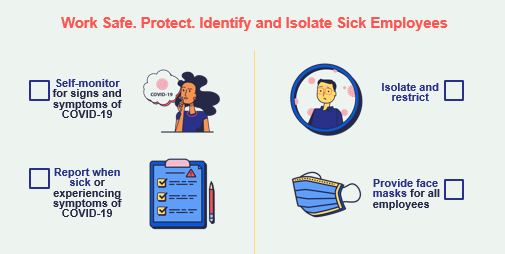Behavior change is something Obsidian Learning has been addressing for the past twenty years through custom communication and training projects. In the current era of remote learning, it is important to continue applying learning and change management concepts to ensure effective information delivery and desired behavior change.
The Occupational Safety and Health Administration (OSHA) recently published its Guidance on Preparing Workplaces for COVID-19 document, a comprehensive collection of rules businesses can use to protect employees and customers from the COVID-19 virus. While the information is invaluable, the document itself is not learning friendly. As our contribution to combatting the pandemic, Obsidian Learning repackaged the OSHA guidance and created a series of easy to access, effective eLearning modules. As a result, several clients requested additional deliverables to support their employees’ learning process. Here, we focus on one particular step in the OSHA guidance document, how we transformed the guidance into a functional tool, and our larger philosophy of how to effectively transmit a series of such guidelines in the most effective manner.
In Step 3 of our free course , OSHA stresses that “prompt identification and isolation of potentially infectious individuals is a critical step in protecting workers, customers, visitors, and others at a worksite.”

This is easier for some businesses than others. For health workers, for example, it’s a no brainer: isolation procedures and tools exist and are systematically employed. However, imagine a 24-hour continuously operating manufacturing company. How would you follow this guidance under those circumstances? Our approach was to develop a visually arresting, concise infographic checklist to help managers determine the proper course of action.
- Encourage workers to self-monitor for signs and symptoms of COVID-19.
- Develop specific procedure for workers to report when they are sickor experiencing symptoms of COVID-19.
- Isolate and restrict. If employees exhibit signs and/or symptoms of COVID-19, immediately move them to a single room and restrict access to that space until medical evaluation can be made.
- Provide face masks for all employees who can wear them (if they are not already required to use respirators or other breathing protective equipment).

More broadly, how do you communicate such policies to new and existing employees? You could send out a mass email blast, or perhaps hold staff tailgate meetings at the beginning of each shift. Keep in mind, though, that this is one new guideline among many that you need to communicate. Rather than sending ten emails, or even one very long one, consider creating a series of resources and learning interactions that pull together all the new regulations and guidelines. Online, short, effective eLearning courses like this , small interactions, infographics, and checklists combine to form a useful training program. All resources should be visually cohesive, relevant to the individual’s workspace, searchable, and easily accessible.
Always provide information in the language your audience speaks best and use the communication methods your audience is most familiar with. Make sure all content is simple, concise, and relevant. And if you need help, reach out to us . Obsidian Learning can help.







